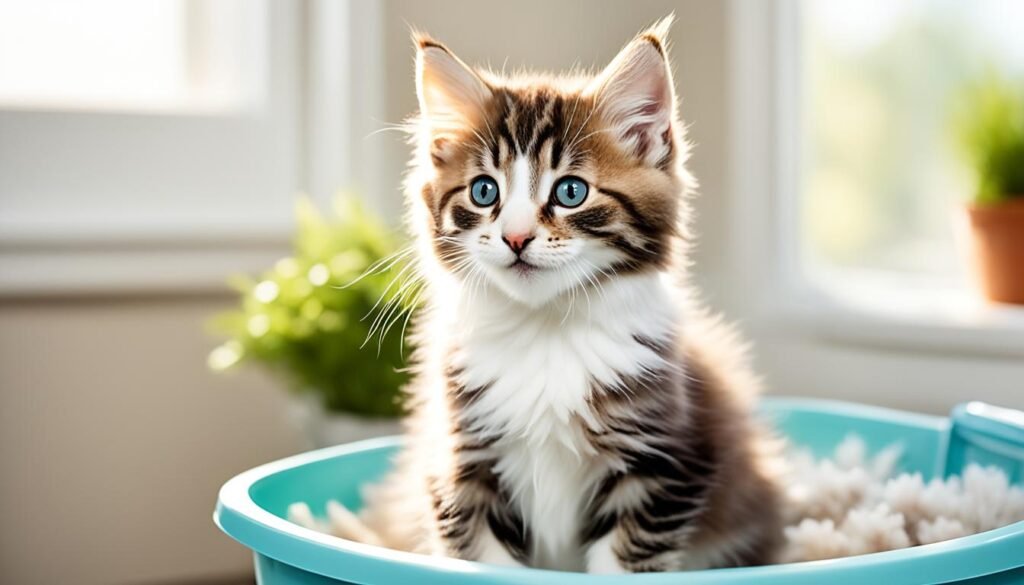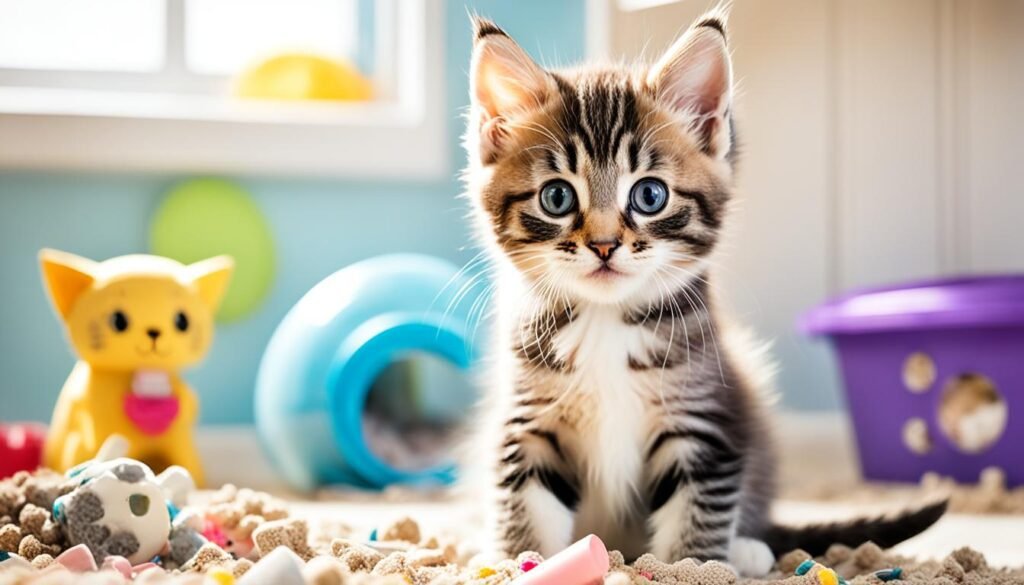Welcome to kitten care, where litter training is key. It’s the start of a happy life with your pet. Teaching them to use the litter box is about keeping your home clean. It also builds good habits for a lifetime.
Our advice turns litter training into a great bonding time. The litter box isn’t just a bathroom for your kitten. It’s where trust grows. Let’s start this journey to make litter box training positive. It will help your kitten’s behavior and health.
Let’s explore methods that meet your kitten’s natural needs. This makes transitioning to using the litter box smooth. Remember, being patient and consistent helps them learn. This is crucial in their first weeks of life.
Understanding the Basics of Litter Training Kittens
Starting to litter train kittens is key for their health and your happiness. It’s important to know the right time to begin, what litter to use, and how to make a cozy litter box area. This will help build good lifelong habits for your kitten’s litter box use. Here is an easy guide to start this important step in your kitten’s life.
Start Litter Training at the Right Age
Kittens should start litter training when they are about 3-4 weeks old. Around this time, they start looking for a particular spot to go to the bathroom. This makes it the best time to show them the litter box. Waiting for these natural signs makes training them easier.
Choose the Right Type of Litter for Your Kitten
Choosing the right litter is vital for kittens. It should be safe and comfy. Since kittens have tender paws and like to dig and cover their waste, the litter must be soft and safe. It shouldn’t harm them if they eat it or hurt their skin.
Establishing a Comfortable Litter Box Environment
Setting up a welcoming litter box area is also crucial. Important things to think about are:
- The litter box must be big enough for your kitten to move and turn around comfortably.
- It should be in a spot that’s easy to get to, quiet, and away from busy areas for privacy.
- Keeping the box clean is key, as kittens, like adult cats, prefer a clean spot for their needs.
Considering these factors makes a friendly space for kittens. This encourages them to use their litter boxes properly. It helps avoid accidents and teaches them good habits.
Creating a Positive Litter Box Experience for Your Kitten

The goal of kitten litter box training is to make it a good experience. This helps your kitten want to use the box all the time. By using methods that promote use and offering rewards, your kitten will learn good habits for life.
Rewarding the behavior you want to see is key. For example, praise or a treat right after your kitten uses the litter box works well. This creates a link between the action and a happy result. Positive reinforcement like this makes training faster and litter box use more regular.
- Place your kitten in the litter box after meals and naps to encourage use.
- Use treats and affection as rewards for proper litter box usage.
- Keep the litter box in a quiet, accessible location to make it inviting for your kitten.
- Always clean the box regularly to maintain a hygienic environment.
To show how positive reinforcement works in kitten litter box training, look at this table:
| Technique | Description | Benefit |
|---|---|---|
| Gentle Introduction | Placing the kitten in the box and softly scratching the litter with their paw | Helps the kitten associate the box with natural digging behavior |
| Praise | Verbal affirmation immediately after the kitten uses the box | Reinforces positive behavior with a loving response |
| Treats | Providing a small food treat following correct litter box usage | Creates a favorable association with the litter box |
| Consistent Routine | Establishing set times for placing the kitten in the box | Promotes regular use and helps prevent accidents |
Making litter box use a positive experience can easily fit into your kitten’s daily life. By focusing on these training methods, your kitten will do well. This leads to a happy life for both of you.
Selecting the Ideal Location for the Litter Box
Choosing the right spot for your kitten’s litter box takes more than just finding an empty corner. The perfect spot must be easy to get to and respect your cat’s desire for privacy and safety. It should also fit well with your home’s setup and daily life. We’ll look at the expert advice on what to consider, making sure your furry friend feels at ease in their space.
Factors to Consider When Placing Your Kitten’s Litter Box
The best place to put the box is somewhere quiet, with little people walking by, and where your kitten can get to it easily but without being too noticed. Keep it away from noisy machines and places where loud sounds can happen. This can make your kitten scared of using the box. It’s also good to not put it near where your kitten eats or drinks. They like to keep their eating and bathroom spots separate.
How Many Litter Boxes Should You Have?
The rule of thumb is to have one more litter box than the number of cats you have. For one kitten, having two boxes in different great spots can stop them from feeling like another cat owns the space. This is really helpful if you live in a house with more than one floor. The number of boxes can really affect how well your cat uses the litter box. It can also lower the chances of them going to the bathroom in the wrong place.
Eliminating Negative Associations with the Litter Box
Keeping things consistent with cleaning and where the box is can help stop bad associations with it. Cleaning regularly keeps smells under control and makes your kitten more likely to use their box. If they go to the bathroom outside the box, cleaning it well can stop them from doing it again. Look at changing things up to make it better. This could mean trying a different litter or moving the box to a new spot.
| Tips for Ideal Litter Box Placement | Reasons |
|---|---|
| Away from High Traffic Areas | Less disturbance means more privacy and less stress |
| Separate from Feeding Areas | Instinctual behavior to keep eating and waste areas apart |
| Multiple Options for Multi-Cat Homes | Reduces territorial stress and gives cats alternative options |
| Accessible but Discreet | Encourages use while maintaining a clean aesthetic for owners |
| Quiet and Safe | Prevents negative associations with startling noises or threats |
Kitten Litter Box Training Techniques

Teaching your cat to use a litter box takes patience, careful watching, and the correct method. We’ll cover how to teach your kitten about the litter box, how to check on their progress, and solve any problems that pop up.
Introducing Your Kitten to the Litter Box
Making the litter box welcoming is key to a good start. Put the box in a quiet spot where your kitten won’t be disturbed. Help your kitten get used to the box by placing them in it after eating or sleeping. Always be kind and use treats or praise to make litter box time a happy time.
Monitoring Your Kitten’s Litter Box Use
It’s important to watch how often your kitten uses the litter box. Keep an eye on their habits to catch any changes. Paying attention helps you spot health issues early and tells you how well they’re learning.
Addressing Common Litter Box Issues
Sometimes kittens don’t like their litter, or they might not use the box properly. If you’re having trouble, try different kinds of litter, add more boxes, or talk to a vet to check for health problems.
| Issue | Possible Cause | Troubleshooting Tip |
|---|---|---|
| Aversion to Litter Box | Dislike of litter texture or scent | Try unscented, finer-textured litter |
| Inconsistent Use | Litter box location not ideal | Move to a quiet, accessible area |
| Health-Related Issues | Urinary infections or other ailments | Consult with a veterinarian |
Staying patient and attentive is essential during litter box training. Apply these tips, keep introducing good habits, watch how your kitten is doing, and deal with any issues. You’ll create a clean and healthy space for your growing pet.
Maintaining Good Litter Box Hygiene and Habits
For cat owners, maintaining good litter box hygiene is crucial for their pet’s health and comfort. Regular litter box maintenance helps stop the spread of harmful bacteria. It also reduces bad smells in the home. Cleaning the litter box isn’t fun, but with routine care, it gets easier.
Creating consistent litter box habits is key for your cat’s happiness. This means not just scooping out waste, but also changing the litter and washing the box. It’s about making the box clean and cozy for your cat.
- Every day, scoop out waste from the litter box. This keeps the box clean and cuts down on smell.
- Every one to two weeks, throw out all the litter. Clean the box with gentle soap and water.
- To keep odors low between cleanings, use litter deodorizers or baking soda.
- Think about the type of litter you use. Some types are better at controlling odor.
- Put litter mats around the box. They help keep litter from spreading around your home.
Here’s a simple table to help you keep track of your litter box cleaning routine:
| Task | Daily | Weekly | Monthly |
|---|---|---|---|
| Scoop Waste | ✔ | ✔ | ✔ |
| Top Up Litter | ✔ | ✔ | |
| Litter Replacement | ✔ | ||
| Box Washing | ✔ | ✔ | |
| Deodorize | ✔ |
Keeping to a cleaning schedule helps you and your cat stay clean and comfortable. A clean litter box means a happy cat. And a happy cat makes for a happy home!
Teaching Kitten Litter Box Etiquette and Consistency
Training your kitten to use the litter box is vital for a tidy home. You’ll need to teach them the right way to use it and be consistent. Using positive feedback and keeping the box clean will help your kitten learn quickly.
Reinforcing Litter Box Training Through Positive Reinforcement
Positive reinforcement makes litter box training stick. Reward your kitten right after they use the litter box. Treats, love, or kind words can make a big difference in training.
Regularly Cleaning and Refreshing the Litter Box
Keeping the litter box clean is crucial. A clean box will make your kitten want to use it. Remember to scoop daily and add fresh litter often.
- Clean litter boxes at least once a week with mild detergent
- Keep the litter box location consistent and easily accessible
- Replace the entire litter and clean the box monthly
Transitioning From Training to Habitual Use
Moving from training to your kitten using the box on their own takes time. It requires your patience and consistent effort.
| Stage of Training | Actions | Expected Outcome |
|---|---|---|
| Initial Introduction | Show your kitten the litter box location and gently place them inside | Kitten learns where the litter box is and begins to show interest |
| Reinforcement Period | Use treats and praise to reward litter box use | Kitten associates litter box use with positive outcomes |
| Habitual Use | Monitor less closely but maintain a clean litter box environment | Kitten independently uses the litter box consistently |
Conclusion
We’ve come to the end of our guide on teaching kittens to use the litter box. It’s a big step to make sure your pet is healthy and happy. Kittens are naturally curious and learn quickly. With the right guidance, they can master good litter box habits.
This guide has shared a wealth of knowledge on how to train your kitten. We talked about choosing the right litter, the box, and keeping it clean. All these strategies help your kitten learn to use the box as part of their daily routine. The aim was to give you all the tools you need for a clean, peaceful home with your kitten.
In wrapping up, we’ve shown how to successfully train your kitty to use their box. With expert advice and careful planning, creating good litter box habits is not just hope—it’s achievable. We hope this guide helps you and your kitten live happily, with the confidence of proper litter box use.
FAQ
When should I start litter training my kitten?
Start when your kitten is 3-4 weeks old. They should start doing their business on their own by then.
What type of litter should I use for my kitten?
Use litter that’s safe for kittens. Options include clumping litter or clay litter.
How can I create a comfortable litter box environment for my kitten?
Make sure the litter box fits your kitten right. It should be in a quiet spot. Add cozy bedding material too.
How can I create a positive litter box experience for my kitten?
Lead them to the litter box after eating or sleeping. Use treats and praise to make it a good habit.
Where is the ideal location to place my kitten’s litter box?
The spot should be easy to get to, private, and not near loud areas. Keep it away from where they eat and drink.
How many litter boxes should I have for my kitten?
Have at least one litter box per kitten, plus an extra one. This helps avoid accidents.
What should I do if my kitten has negative associations with the litter box?
Use treats and a calm setting to slowly get them liking the litter box.
How do I introduce my kitten to the litter box?
Place them gently in the box. If they’re unsure, show them how to dig.
How can I monitor my kitten’s litter box use?
Watch how they act and check the box often. Talk to a vet if their habits change.
What should I do if my kitten is not using the litter box consistently?
First, see if a vet can help. Make sure the box is clean. Stay patient and avoid scolding.
How often should I clean the litter box?
Clean it daily and change the litter every 1-2 weeks. This keeps things fresh and stops bad smells.
How do I transition my kitten from litter training to habitual use of the litter box?
Keep up the positive reinforcement as they get better. Lessen your supervision slowly. Keep the box clean and easy to get to.













